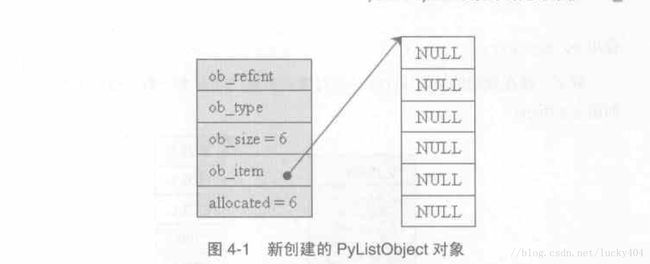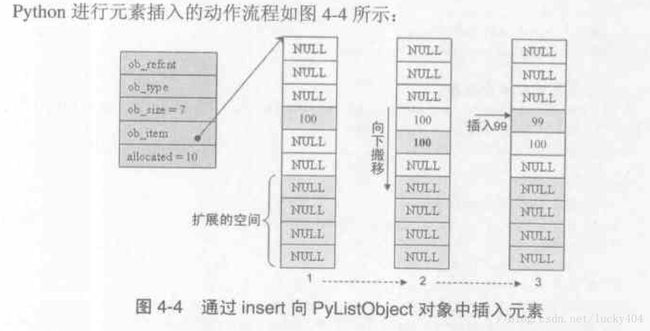Python 列表源码解析
列表作为python 最常用的一种数据类型, 一直很好奇其是如何实现动态的扩展的,于是上github看了源代码(https://github.com/python/cpython/blob/master/Include/listobject.h, https://github.com/python/cpython/blob/master/Objects/listobject.c),结合《python源码剖析》分享一下自己的收获!
列表源码定义
#ifndef Py_LIMITED_API
typedef struct {
PyObject_VAR_HEAD
/* Vector of pointers to list elements. list[0] is ob_item[0], etc. */
PyObject **ob_item;
/* ob_item contains space for 'allocated' elements. The number
* currently in use is ob_size.
* Invariants:
* 0 <= ob_size <= allocated
* len(list) == ob_size
* ob_item == NULL implies ob_size == allocated == 0
* list.sort() temporarily sets allocated to -1 to detect mutations.
*
* Items must normally not be NULL, except during construction when
* the list is not yet visible outside the function that builds it.
*/
Py_ssize_t allocated;
} PyListObject;
#endifallocated 记录了这个列表申请的内存大小, 假如一个列表中可以容纳10个元素,则allocated 就是10,当我们往列表中添加或者删除元素时这个大小都会跟着改变
ob_size 则是记录了当前列表中 已经使用的大小
allocated 和 ob_size 都和内存管理有关,python的列表总是会被频繁的添加或者删除元素,因此频繁的申请释放内存显然是不明智的,所以python的列表在创建时总是会申请一大块内存,申请的内存大小就记录在 allocated 上, 已经使用的就记录在 ob_size
列表创建
通过PyAPI_FUNC(PyObject *) PyList_New(Py_ssize_t size); 方法来创建
该方法需要指定 创建列表容量的大小
创建列表代码如下
PyList_New(Py_ssize_t size)
{
PyListObject *op;
#ifdef SHOW_ALLOC_COUNT
static int initialized = 0;
if (!initialized) {
Py_AtExit(show_alloc);
initialized = 1;
}
#endif
if (size < 0) {
PyErr_BadInternalCall();
return NULL;
}
if (numfree) {
numfree--;
op = free_list[numfree];
_Py_NewReference((PyObject *)op);
#ifdef SHOW_ALLOC_COUNT
count_reuse++;
#endif
} else {
op = PyObject_GC_New(PyListObject, &PyList_Type);
if (op == NULL)
return NULL;
#ifdef SHOW_ALLOC_COUNT
count_alloc++;
#endif
}
if (size <= 0)
op->ob_item = NULL;
else {
op->ob_item = (PyObject **) PyMem_Calloc(size, sizeof(PyObject *));
if (op->ob_item == NULL) {
Py_DECREF(op);
return PyErr_NoMemory();
}
}
Py_SIZE(op) = size;
op->allocated = size;
_PyObject_GC_TRACK(op);
return (PyObject *) op;
}新建列表主要做了:
1 参数检查 列表大小不能是 0
2 检查是否有缓存可用
3 内存检查 检查新建的列表大小不能超过 内存大小
4 申请内存 新建列表
5 为allocated 设置初始化的值
列表设置元素的实现
lst = list()
lst[0] = "hello world"
当通过 PyObject_GC_New 创建列表之后,其实里面的元素都是null
假如 我们要给lst 第n元素赋值 其实就是通过 PyList_SetItem(PyObject *op, Py_ssize_t i, 方法来实现的
PyObject *newitem)
代码如下:
PyList_SetItem(PyObject *op, Py_ssize_t i,
PyObject *newitem)
{
PyObject **p;
if (!PyList_Check(op)) {
Py_XDECREF(newitem);
PyErr_BadInternalCall();
return -1;
}
if (i < 0 || i >= Py_SIZE(op)) {
Py_XDECREF(newitem);
PyErr_SetString(PyExc_IndexError,
"list assignment index out of range");
return -1;
}
p = ((PyListObject *)op) -> ob_item + i;
Py_XSETREF(*p, newitem);
return 0;
}设置元素的过程大致的步骤是
1 参数类型检查
2 索引 有效性检查 不可超出索引
3 设置元素
列表 insert 插入元素的实现
插入元素 使用的是ins1(PyListObject *self, Py_ssize_t where, PyObject *v) 方法来实现
源码 如下
ins1(PyListObject *self, Py_ssize_t where, PyObject *v)
{
Py_ssize_t i, n = Py_SIZE(self);
PyObject **items;
if (v == NULL) {
PyErr_BadInternalCall();
return -1;
}
if (n == PY_SSIZE_T_MAX) {
PyErr_SetString(PyExc_OverflowError,
"cannot add more objects to list");
return -1;
}
if (list_resize(self, n+1) < 0)
return -1;
if (where < 0) {
where += n;
if (where < 0)
where = 0;
}
if (where > n)
where = n;
items = self->ob_item;
for (i = n; --i >= where; )
items[i+1] = items[i];
Py_INCREF(v);
items[where] = v;
return 0;
}其主要实现过程 如下
1 参数检查
2 从新调整列表容量 通过 list_resize 方法确定 是否需要申请内存
3 确定插入点
4 插入元素
可以看到列表插入时 都会将后面的位置的元素重新移动
列表的append 实现
通过 PyList_Append(PyObject *op, PyObject *newitem) 方法来实现
源码如下:
PyList_Append(PyObject *op, PyObject *newitem)
{
if (PyList_Check(op) && (newitem != NULL))
return app1((PyListObject *)op, newitem);
PyErr_BadInternalCall();
return -1;
}其主要是调用了 app1(PyListObject *self, PyObject *v) 来实现的
app1 方法主要做了以下工作
1 参数检查
2 容量检查
3 调用
list_resize方法检查是否需要申请内存4 添加元素
列表转元组
列表转元组其实就是新建一个大小和列表一样大小的数组,并将该列表内的元素添加到元组中
源码如下:
PyObject *
PyList_AsTuple(PyObject *v)
{
PyObject *w;
PyObject **p, **q;
Py_ssize_t n;
if (v == NULL || !PyList_Check(v)) {
PyErr_BadInternalCall();
return NULL;
}
n = Py_SIZE(v);
w = PyTuple_New(n);
if (w == NULL)
return NULL;
p = ((PyTupleObject *)w)->ob_item;
q = ((PyListObject *)v)->ob_item;
while (--n >= 0) {
Py_INCREF(*q);
*p = *q;
p++;
q++;
}
return w;
}列表的反转 reverse
列表的反转是就地反转的,不会生成新的列表, 循环当前列表 使用了一个第三变量,然后将元素移位
static void
reverse_slice(PyObject **lo, PyObject **hi)
{
assert(lo && hi);
--hi;
while (lo < hi) {
PyObject *t = *lo;
*lo = *hi;
*hi = t;
++lo;
--hi;
}
}关于 列表的 extend 方法 看了源码才知道,只要是可迭代对象都可以放入extend(), 字典,元组,字符串都可以
部分 源码定义 如下
if (PyList_CheckExact(iterable) || PyTuple_CheckExact(iterable) ||
(PyObject *)self == iterable) {
PyObject **src, **dest;
iterable = PySequence_Fast(iterable, "argument must be iterable");
if (!iterable)
return NULL;还有很多的方法等着你们去探索和发现, 更多列表实现的源代码请看:
https://github.com/python/cpython/blob/master/Objects/listobject.c

